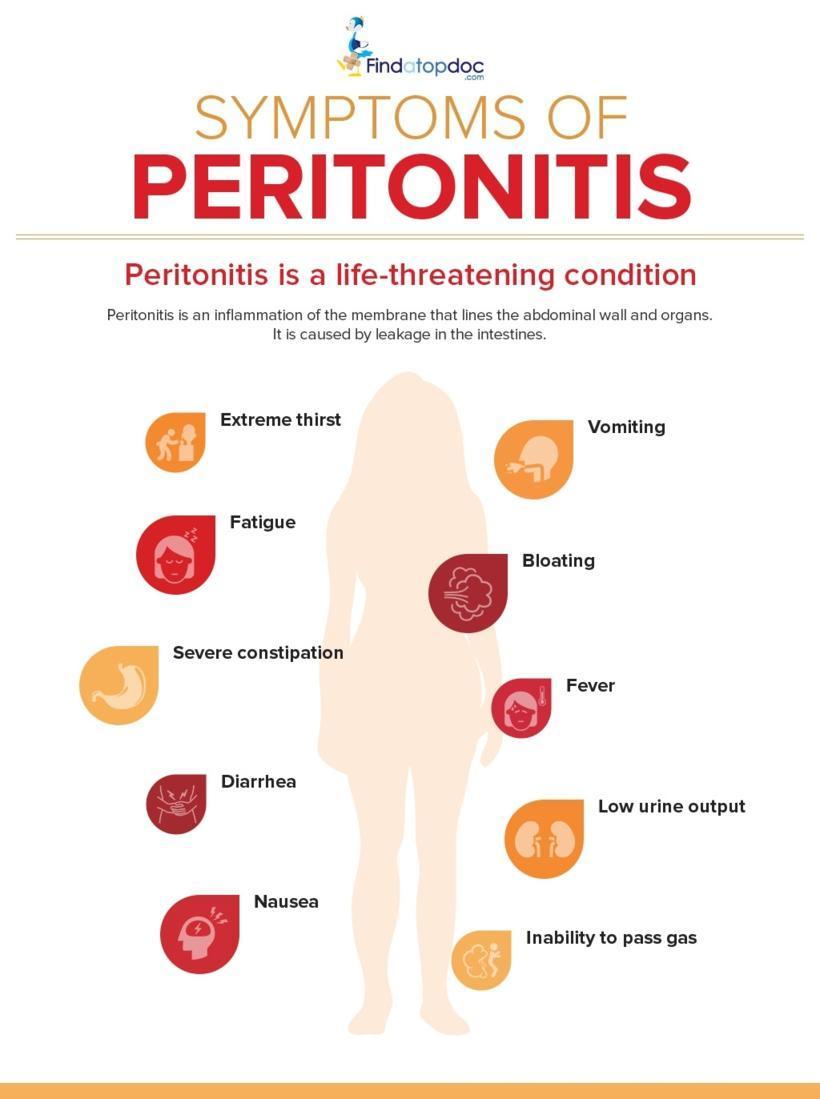
Peritonitis is inflammation of the peritoneum — a silk-like membrane that lines your inner abdominal wall and covers the organs within your abdomen — that is usually due to a bacterial or fungal infection. Peritonitis can result from any rupture (perforation) in your abdomen, or as a complication of other medical conditions. Peritonitis requires prompt medical attention to fight the infection and, if necessary, to treat any underlying medical conditions. Treatment of peritonitis usually involves antibiotics and, in some cases, surgery. Left untreated, peritonitis can lead to severe, potentially life-threatening infection throughout your body.
Symptoms
Signs and symptoms of peritonitis include:
- Abdominal pain or tenderness
- Bloating or a feeling of fullness (distention) in your abdomen
- Fever
- Nausea and vomiting
- Loss of appetite
- Diarrhea
- Low urine output
- Thirst
- Inability to pass stool or gas
- Fatigue
If you’re on peritoneal dialysis, your dialysis fluid may appear cloudy or have white flecks or clumps in it. You may also notice redness or feel pain around your catheter. There are two types of peritonitis. Spontaneous bacterial peritonitis (SBP) is the result of an infection of the fluid in your peritoneal cavity. Liver or kidney failure can cause this condition. People on peritoneal dialysis for kidney failure are also at increased risk for SBP. Secondary peritonitis is usually due to an infection that has spread from your digestive tract. The following conditions can lead to peritonitis:
- an abdominal wound or injury
- a ruptured appendix
- a stomach ulcer
- a perforated colon
- diverticulitis, which is when pouches form on the wall of the colon and become inflamed
- pancreatitis, which is an inflammation of the pancreas
- cirrhosis of the liver or other types of liver disease
When to see a doctor
Peritonitis can be life-threatening if it's not treated promptly. Contact your doctor immediately if you have severe pain or tenderness of your abdomen, abdominal bloating, or a feeling of fullness associated with:
- Fever
- Nausea and vomiting
- Low urine output
- Thirst
- Inability to pass stool or gas
If you're receiving peritoneal dialysis, contact your health care provider immediately if your dialysis fluid is cloudy, if it contains white flecks, or strands or clumps (fibrin), or if it has an unusual odor, especially if the area around your tube (catheter) is red or painful.
Risk factors
Factors that increase your risk of peritonitis include:
- Peritoneal dialysis. Peritonitis is common among people undergoing peritoneal dialysis therapy.
- Other medical conditions. The following medical conditions increase your risk of developing peritonitis: cirrhosis, appendicitis, Crohn's disease, stomach ulcers, diverticulitis and pancreatitis.
- History of peritonitis. Once you've had peritonitis, your risk of developing it again is higher than it is for someone who has never had peritonitis.
Treatment
You may need to be hospitalized for peritonitis that's caused by infection from other medical conditions (secondary peritonitis). Treatment may include:
- Antibiotics. You'll likely be given a course of antibiotic medication to fight the infection and prevent it from spreading. The type and duration of your antibiotic therapy depend on the severity of your condition and the kind of peritonitis you have.
- Surgery. Surgical treatment is often necessary to remove infected tissue, treat the underlying cause of the infection, and prevent the infection from spreading, especially if peritonitis is due to a ruptured appendix, stomach or colon.
If you've had spontaneous peritonitis before or if you have peritoneal fluid buildup due to a medical condition such as cirrhosis, your doctor may prescribe antibiotics to prevent peritonitis. If you’re taking a proton pump inhibitor, your doctor may ask you to stop taking it.


